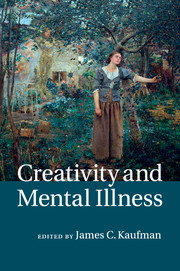Crossref Citations
This Book has been
cited by the following publications. This list is generated based on data provided by Crossref.
Simonton, Dean Keith
2014.
The Mad-Genius Paradox.
Perspectives on Psychological Science,
Vol. 9,
Issue. 5,
p.
470.
Werner, Christian H.
Tang, Min
Kruse, Joachim
Kaufman, James C.
and
Spörrle, Matthias
2014.
The Chinese Version of the Revised Creativity Domain Questionnaire (CDQ‐R): First Evidence for its Factorial Validity and Systematic Association with the Big Five.
The Journal of Creative Behavior,
Vol. 48,
Issue. 4,
p.
254.
Abraham, Anna
2015.
Editorial: Madness and creativity—yes, no or maybe?.
Frontiers in Psychology,
Vol. 6,
Issue. ,
Kaufman, James C.
2015.
Creativity Is Life: A Commentary on the Special Issue.
The Journal of Creative Behavior,
Vol. 49,
Issue. 3,
p.
233.
Beghetto, Ronald A.
and
Kaufman, James C.
2015.
Promise and Pitfalls in Differentiating Amongst the Cs of Creativity.
Creativity Research Journal,
Vol. 27,
Issue. 2,
p.
240.
McGraw, A. Peter
Percival Carter, Erin
and
Harman, Jennifer
2016.
Humor Production and Perceptions of Psychological Health.
SSRN Electronic Journal,
Schweizer, T. Sophie
Schmalenberger, Katja M.
Eisenlohr-Moul, Tory A.
Mojzisch, Andreas
Kaiser, Stefan
and
Funke, Joachim
2016.
Cognitive and Affective Aspects of Creative Option Generation in Everyday Life Situations.
Frontiers in Psychology,
Vol. 07,
Issue. ,
Daniel, Ryan
2016.
Exploring artistic identity and place in society: perspectives and insights from higher education students in Australia.
Creative Industries Journal,
Vol. 9,
Issue. 1,
p.
15.
Kaufman, James C.
Glǎveanu, Vlad P.
and
Baer, John
2017.
The Cambridge Handbook of Creativity across Domains.
p.
3.
Oatley, Keith
and
Djikic, Maja
2017.
The Cambridge Handbook of Creativity across Domains.
p.
63.
Holinger, Molly
Glăveanu, Vlad P.
Kaufman, James C.
and
Baer, John
2017.
The Cambridge Handbook of Creativity across Domains.
p.
635.
Pérez-Fabello, María José
and
Campos, Alfredo
2017.
Dissociative Experiences and Vividness of Auditory Imagery.
Creativity Research Journal,
Vol. 29,
Issue. 2,
p.
200.
Simonton, Dean Keith
2017.
The Cambridge Handbook of Creativity and Personality Research.
p.
235.
Daniel, Ryan
and
Johnstone, Robert
2017.
Becoming an artist: exploring the motivations of undergraduate students at a regional Australian University.
Studies in Higher Education,
Vol. 42,
Issue. 6,
p.
1015.
Taylor, Christa L.
McKay, Alexander S.
and
Kaufman, James C.
2017.
The Cambridge Handbook of Creativity and Personality Research.
p.
167.
Kaufman, James C.
2017.
From the Sylvia Plath Effect to social justice: Moving forward with creativity.
Europe’s Journal of Psychology,
Vol. 13,
Issue. 2,
p.
173.
Damian, Rodica Ioana
2017.
The Cambridge Handbook of Creativity and Personality Research.
p.
102.
Wang, Lixia
Long, Haiying
Plucker, Jonathan A.
Wang, Qing
Xu, Xiaobo
and
Pang, Weiguo
2018.
High Schizotypal Individuals Are More Creative? The Mediation Roles of Overinclusive Thinking and Cognitive Inhibition.
Frontiers in Psychology,
Vol. 9,
Issue. ,
Simonton, Dean Keith
2018.
Creative Genius as Causal Agent in History: William James's 1880 Theory Revisited and Revitalized.
Review of General Psychology,
Vol. 22,
Issue. 4,
p.
406.
Secker, Jenny
Heydinrych, Kirsten
Kent, Lyn
and
Keay, Jo
2018.
Why art? Exploring the contribution to mental well-being of the creative aspects and processes of visual art-making in an arts and mental health course.
Arts & Health,
Vol. 10,
Issue. 1,
p.
72.



